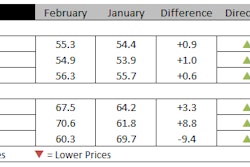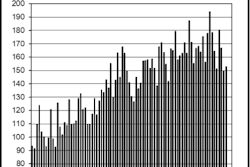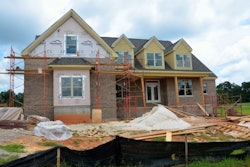Construction News Tracker is presented by Caterpillar and produced by ForConstructionPros.com.
The National Association of Home Builders/Wells Fargo Housing Market Index continues to expand — despite, or perhaps because of, housing starts late December plunge. U.S. housing starts fell in three of the last four months of 2018 to a December low not seen since September of 2016. Since the first of the year the FED has softened its intent to continue raising interest rates, and the February Housing Market Index hit 62 for the second consecutive month, reflecting rising consumer confidence and lower single-family mortgage rates. Current sales conditions in the single-family market rose to 67, while the component gauging six-month expectations rose to 58. This monthly survey has been conducted now for 30 years and gauges builder perceptions of single-family markets nationwide.
IHS Markit is reporting the cost of goods and services for contractors rose for the 28th consecutive month in February, pushing their index to 55.3 as any number above 50 indicates widespread price increases. Eight of the 12 IHS Markit subcomponents showed movement with steel weak or flat while costs for pumps or turbines rose. Subcontractor labor costs are up again indicating a tight labor market nationwide.
Dodge Data reports the value of new construction starts in January gained 2% compared with December, reaching a seasonally adjusted rate of $722.5 billion. If you recall, total construction dropped 7% in November and 10% in December. Each of the three main construction sectors gained steam in January with residential building up 4%, nonresidential building up a percent as commercial projects came online, and nonbuilding construction was up a percent as large utility projects were underway. The Dodge Index produced a reading of 153, up from December's mark of 150. Dodge Data claims that construction starts were particularly strong in June and October then tapered off in following months as a pattern developed last year, and Dodge Chief Economist Robert Murray says 2019 construction starts should be consistent with last year's volume.
Newly elected California Governor Gavin Newsom is effectively gutting the state's $77 billion high speed rail project. Initially slated to run from Los Angeles to San Francisco, the Governor has ordered it be substantially reduced to operations only in the central valley from Bakersfield to Merced — a distance of 119 miles. With that announcement, the Trump Administration immediately sought to gouge back $3.5 billion in Federal DOT funding allocated to the high speed rail system, but California officials are balking saying those funds have already been spent.
Volvo Construction Equipment is going full bore into electric powered equipment. The company has announced it will launch by mid next year up to 10 electric-powered compact excavators and compact wheel loaders and stop new diesel engine-based development of these models.. Many Volvo competitors have also announced work on electric-powered construction equipment but not yet offered it to the market on this scale. volvo says it has received user confidence to the move to eliminate diesel-powered equipment on this lineup, noting the same sentiment does not apply to its lineup of large excavators and wheel loaders.
There are 51 metropolitan statistical areas (MSA’s) in the U.S. with populations above one million. ConstructConnect has assembled an interesting data pool that shows which cities have or are achieving the greatest dollar amount in construction of medical facilities. As an example, in 2018 leading all cities was Washington D.C. with $1.3 billion in bulding of hospitals clinics and nursing homes followed by:
- Cleveland
- Phoenix
- Cincinnati
- Pittsburgh
- Atlanta
- Orlando
There were five less populous areas with exceptional levels of medical facility construction:
- Lansing, MI
- Fresno, CA
- Bloomington, IN
- Rochester, NY
- Durham, NC
The ConstructConnect data pool also illuminates a number of smaller communities nationwide that have high dollar value of medical facility construction due to their rapid population increases.
The U.S. Energy Information Administration has just published its latest energy outlook for the nation and the first of its forecasts to include 2020. The EIA expects wind power to exceed hydropower in the U.S. this year, for the first time ever. The EIA places wind capacity at 107 gigawatts by the end of 2019 and at 114 gigawatts at the end of 2020. The agency, in forecasting expansion of solar energy, predicts a total of 5 gigawatts will be brought online this year with another 6 gagawatts in 2020. Futher, it's predicted that another 9 gigawatts of residential solar will be produced by next year.
Finally in closing, no inspiration is worthy until someone takes action to make it work.
This is Construction News Tracker looking over the industry that makes the world a better place, presented by Caterpillar and produced by ForConstructionPros.com.
Follow us on social media at Twitter using #constructionnews,YouTube and Facebook as the streaming Web never ends.



















